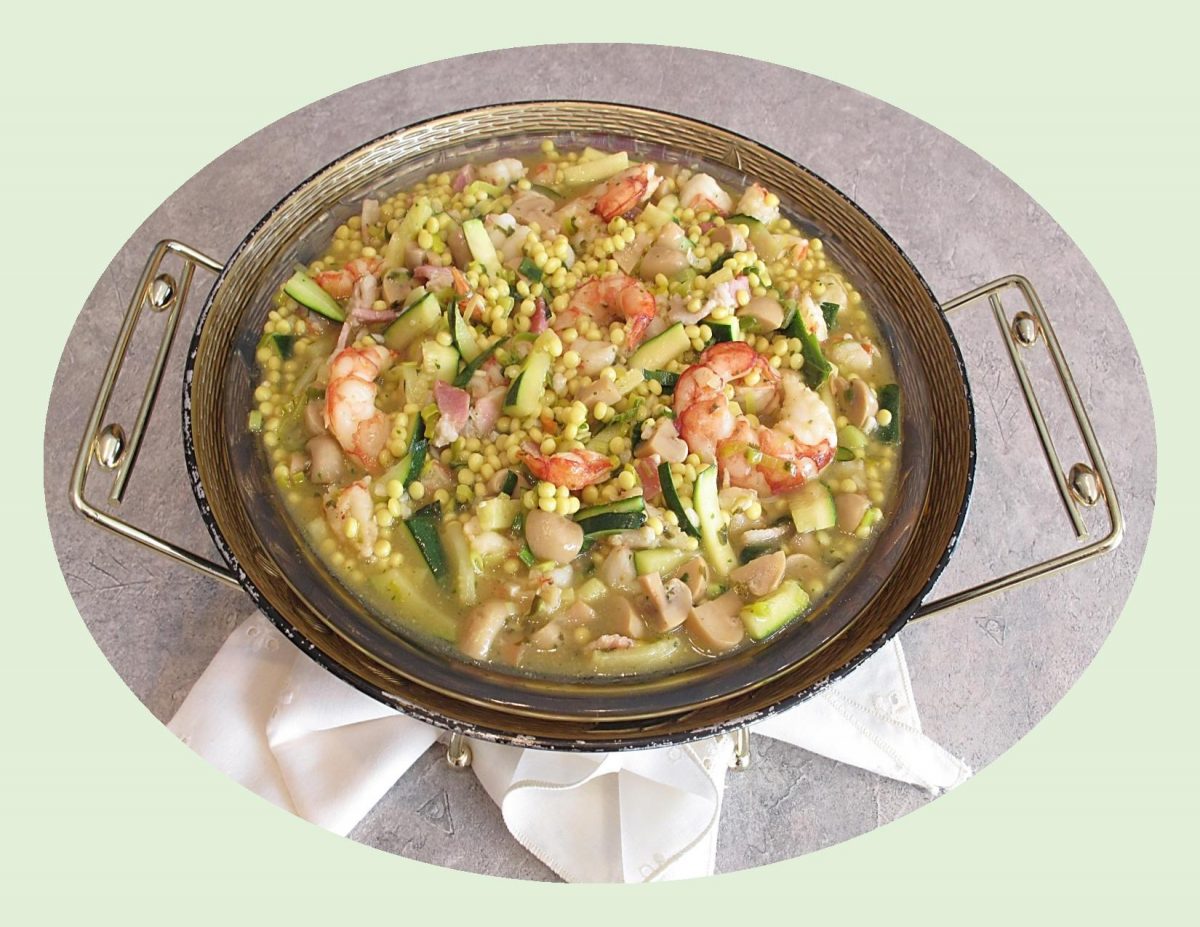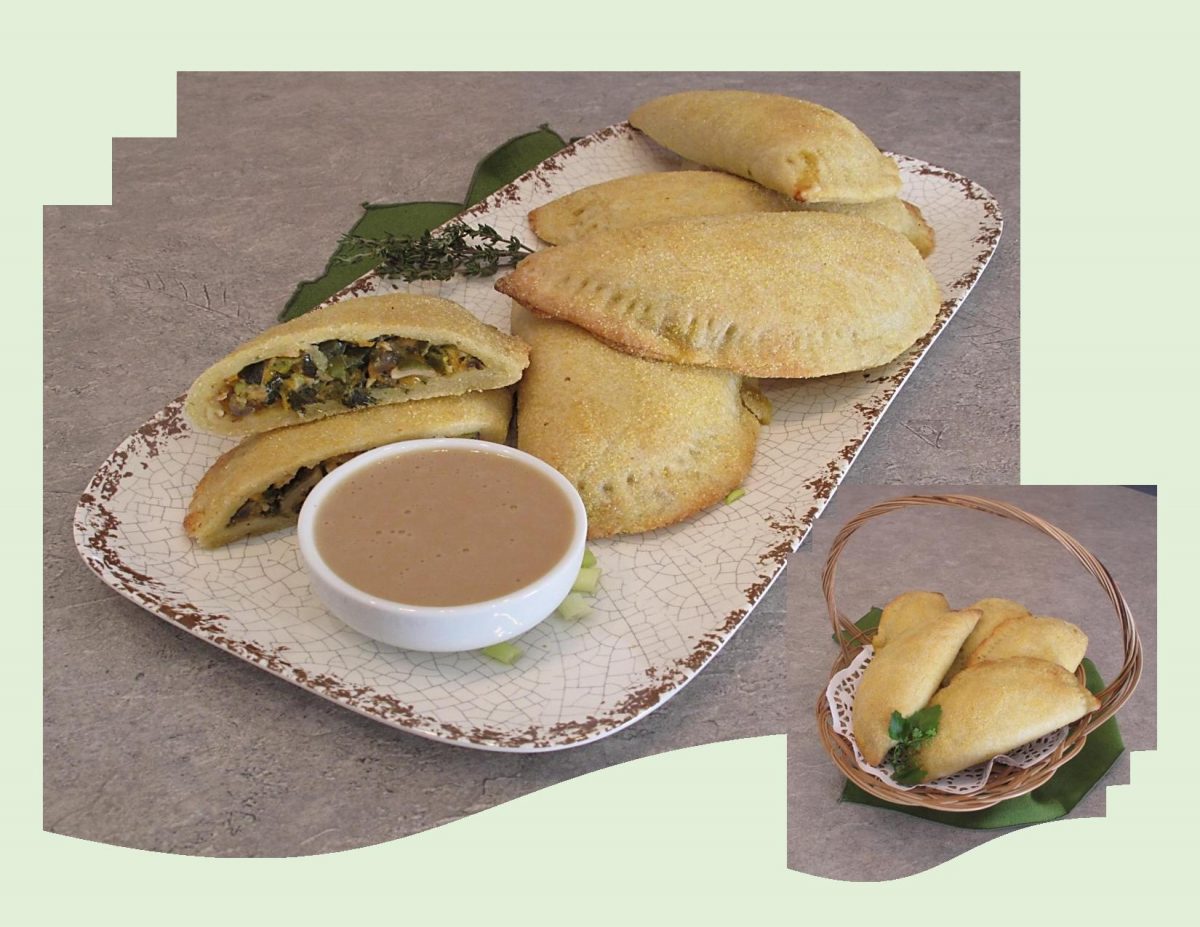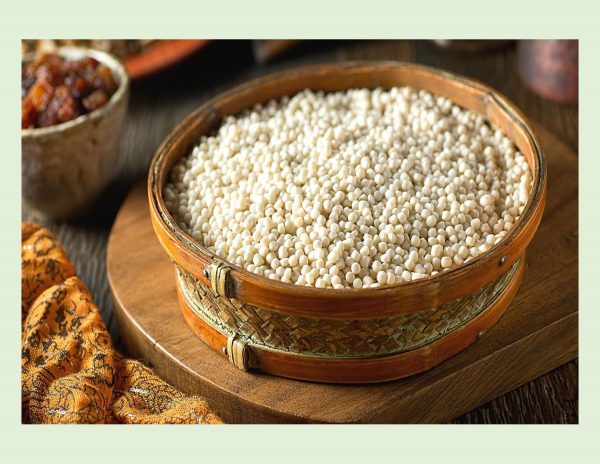
This shrimp vegetable couscous not only makes a fabulous midweek meal for four but can be easily multiplied to accommodate more. The quick cooking couscous turns this simple recipe into a one pot wonder with a fusion of flavors.
Couscous has become one of my favorite pantry staples. It’s quick, convenient, versatile and makes a good alternative to traditional rice or pasta.
There are actually three different kinds of couscous:
Pearl (Israeli) couscous, which resembles tiny pasta shaped like pearls.
Lebanese couscous, which is a bit larger, the size of peas.
Then, there is the smallest size couscous made of fine granules of durum wheat. This one is associated more with Moroccan cooking.
Couscous used to be hand rolled into tiny pasta. It is now available in instant- cook packages or bulk, where couscous has already been pre-cooked by steaming and then dried. This leaves us with the simple task of re-hydrating in water, which typically takes something like 5 minutes!
Print Recipe
Israeli Couscous w/ Shrimp & Zucchini
Votes: 1
Rating: 5
You:
Rate this recipe!
|
|
Votes: 1
Rating: 5
You:
Rate this recipe!
|
Instructions
In a medium saucepan, fry chopped bacon until crisp, about 3 minutes; add shrimp during last few minutes of sautéing. Remove bacon & shrimp to a bowl & set aside.
To saucepan containing bacon drippings, add zucchini, mushrooms, leek, garlic & cilantro; sauté until tender crisp. Add to bacon & shrimp bowl.
To the saucepan, add broth & salt & bring to a boil; add couscous. Cover saucepan & remove from heat; set aside until liquid has been absorbed, about 5-10 minutes.
Add bowl of bacon, vegetables & shrimp; gently stir together with a fork. Serve immediately.

No matter what the stuffing or style is, love for the empanada is not a difficult one to understand. They are cheap, easy to eat, transportable, and versatile.
Empanadas look as good as they taste; perfect food for a picnic. Eating outdoors, spaced apart is probably one of the safest ways to gather during the ongoing pandemic crisis. The great thing about picnicking is that you can do it practically anywhere you can throw a blanket down. If you can’t make it to a park or field, your yard, porch or any flat surface with a little grass (or sand), some sun (& shade) will do.
Empanadas can be eaten for breakfast, lunch and dinner. They can be served as appetizers or snacks (hot or cold), but they can easily make a full and satisfying main course.
The very basics for an empanada are a combination of three things; dough, filling and a cooking method. The dough can be made from wheat flour, cornmeal, mashed plantains, potatoes, yuca, sweet potatoes etc. and the fillings can consist of meat, fish or vegetables. The cooking method is usually to be baked or fried although some can be cooked on a griddle or grill.
According to food historians, empanadas with seafood filling first appeared in a 1520 cookbook, published during the Moorish invasions.
I was real interested to see what I could do to make some salmon empanadas taste special. We found they were good as a hot meal served with the remaining ‘sauce’ or eaten COLD for a picnic lunch.
Print Recipe
Salmon Picnic Empanadas
Votes: 1
Rating: 5
You:
Rate this recipe!
|
|
Votes: 1
Rating: 5
You:
Rate this recipe!
|
Instructions
Cornmeal Pastry
In a small bowl, combine sour cream & ice water; set aside. In a large bowl, whisk together flour, 1/2 cup cornmeal, sugar & salt. Using a pastry blender or finger tips, cut in butter until mixture resembles both coarse crumbs & small peas. Sprinkle the cold sour cream mixture over dough, tossing with a fork to evenly distribute it. Do NOT overwork dough.
Cover bowl with plastic wrap & refrigerate for at least an hour.
Soy Sauce
In a skillet, melt butter & sprinkle with flour. Allow to cook for a few minutes. In a bowl, whisk together broth, milk & soy sauce. Slowly add to flour/butter mixture, stirring constantly until sauce thickens. Remove from skillet & set aside.
Filling
In the skillet, sauté salmon filet in 1 Tbsp oil until JUST cooked. Remove to a dish. With a fork, 'shred' salmon; set aside.
In the skillet, sauté vegetables in remaining Tbsp of oil for a couple of minutes. Add seasonings, shredded salmon, 1/3 cup prepared soy sauce & grated cheddar. Toss to combine; set aside to cool.
Assembly & Baking
Divide chilled pastry into 10 balls. Roll each one in cornmeal. Place a ball between 2 sheets of plastic wrap & roll into a 6-inch circle.
Divide filling into 10 portions. Place a portion on one side of the pastry circle, leaving about a 1/2-inch border (on filled side). With your fingertips, moisten edge of pastry with a bit of milk or water. Flip opposite side over filling & press edges together to enclose it well. Use a fork to make the classic look.
-
Repeat with remaining pastry & filling. Lay empanadas on a baking sheet lined with parchment paper. Bake for about 20 minutes or until pastry is baked & slightly browned.

Borek (buhr-ECK’) is an essential part of life in Turkey. They are made for any occasion and can be eaten at any time of the day.
There are many variations with different kinds of fillings (cheese, potato, meat), different ways to cook them (fried, baked), different kinds of dough (filo, puff), but in the end they are all called ‘borek’.
You might not have have heard of ‘yufka’, but you have probably already eaten it in the dessert called ‘baklava’. Yufka is used in a lot of traditional Turkish recipes. Some say that it may have been the earlier form of phyllo/filo dough.
The dough itself is made from wheat flour, water and a bit of salt. Yufka finds its way onto the table in the form of casseroles, strudel or a filled pastry roll as well as just flat bread. Traditional Turkish specialties such as borek are made from thin sheets of this wheat dough that are filled and rolled.
Brion & I have many wonderful memories of the holiday time we spent in Turkey some years ago.
Print Recipe
Turkish Borek w/ Beef, Leeks & Potato
Votes: 2
Rating: 5
You:
Rate this recipe!
Ingredients
Beef, Leek & Potato Filling
Ingredients
Beef, Leek & Potato Filling
|
Votes: 2
Rating: 5
You:
Rate this recipe!
|
Instructions
Dough
in a medium bowl, whisk together flour & salt. Make a well in the center & pour in the water & oil. Using your fingers, draw the flour in from the sides, working mixture into a sticky dough.
Turn the dough out onto a floured surface & knead, adding more flour as necessary to prevent sticking, until the dough is smooth & elastic, about 3 minutes.
Transfer to the mixing bowl, drizzle with a little bit of oil & turn to coat. Cover the dough with plastic wrap & allow to rest in a draft-free place for 4 hours.
Borek Filling
In a saucepan, stir-fry ground meat with spices. Remove from saucepan, place in a bowl & set aside. Add 2 tablespoons oil to saucepan & sauté leeks & garlic until tender. Microwave potato, peel & mash with Parmesan cheese. Add leeks, garlic, potato & cheese to meat & spices. Season with salt & pepper to taste; combine well.
Assembly & Baking
Preheat oven to 350 F. Grease a round 11-inch diameter baking pan & set aside.
Divide dough into 2 equal pieces. Form each piece into a ball. On a lightly floured surface, roll the balls into very thin rounds, using more flour as needed to prevent sticking.
On one side of the dough, put a line of filling. Try to build a continuous line. Divide the filling between the 2 rounds. Roll the dough making sure filling is in the whole length of the roll.
Form a spiral with the meat roll in the baking pan, starting in the center. Add the second roll to complete the spiral, filling the pan. Brush borek with egg wash, making sure to brush all visible surfaces.
Bake on middle rack for 45 minutes or until pastry is golden. Let it cool for a bit before serving. Borek is best when freshly baked, however it still tastes great if stored in an airtight container for 2-3 days.









